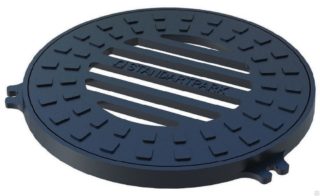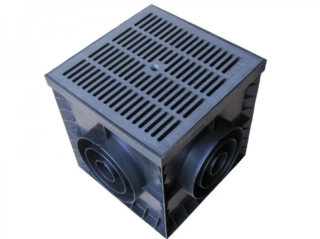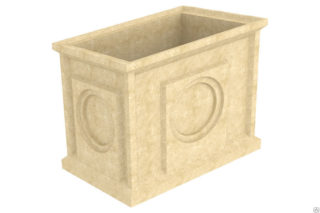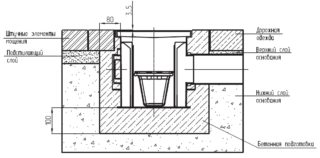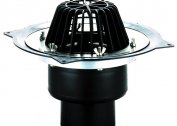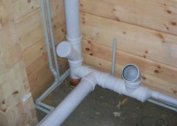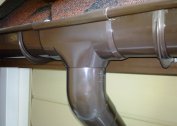Storm water inlets for storm sewers perform the function of collecting surface water and transferring them to the main pipe. Thanks to them, garbage does not enter the system, and rain and melt runoff are sent to the sewer network. Such devices are also installed at enterprises for the removal of conditionally clean waters resulting from industrial activities.
The device and dimensions of stormwater inlets
 Installations for receiving water can be square, rectangular and round. They consist of the following parts:
Installations for receiving water can be square, rectangular and round. They consist of the following parts:
- grates for screening debris, protecting pedestrians from injuries and landscape decoration;
- a water inlet with a basket for directing liquid to the waste system;
- siphon septa;
- sand trap filtering fine debris.
Typically, devices are sold with all the additional parts, but you can only buy a water intake chamber and retrofit the device yourself.
The sizes of storm water inlets vary depending on the purpose and shape. The standard option is a cube with sides of 300 or 400 mm. On the sidewalls, nozzles are provided for connection to highways with a section from 110 to 200 mm. Cubic and other rectangular models can be installed anywhere the stormwater well is located.
A round kind of storm water inlets is more difficult to install, since digging a foundation pit of this shape is not so simple.
To remove liquid from highways, storm inlets in the form of borders are sometimes used. They fit perfectly into the design of the road and are not exposed to the pressure of passing vehicles.
Varieties of storm water inlets
Products are divided according to the permissible load. Each type is marked with a specific letter:
| Marking | Load maximum (t) | Installation locations |
| AND | 1,5 | Garden plots, sidewalks, places without access to transport. |
| AT | 12,5 | At houses and garages, parks and entertainment areas. |
| WITH | 25 | Highways, parking lots, gas stations. |
| D | 40 | Tracks where heavy vehicles are permitted. |
| E | 60 | Road sections with increased traffic load, truck parking, special equipment, near industrial complexes. |
| F | 90 | Airfields, military bases. |
The size and weight of the device depend on the load class. The most durable structures are reinforced concrete with reinforcement and cast iron. Such stormwater inlets can have a mass of up to several tons.
Materials of manufacture
Structures created from ductile iron weigh a lot, but they are durable and not afraid of increased loads.
Other advantages of products from this material include:
- resistance to sharp temperature extremes;
- high throughput;
- resistance to aggressive chemical influences.
Cast iron products are coated with a special anti-corrosion compound, so they practically do not rust. They are made according to GOST and labeled DB, DK and DM, which stands for large, round and small storm water inlets, respectively.
Concrete structures are erected in areas where high pressure acts on the surface. Lightweight options with a wall thickness of 2 cm are suitable for installation under gutters in enterprises. They are connected to the main system with plastic bends.
For roads, heavy devices with a larger wall thickness are needed. They are created from fiber reinforced concrete. The most durable, made of reinforced concrete with a grid of cast iron, are able to constantly support the weight of special equipment and even aircraft.
In household plots, cast iron and concrete structures are not often used.They are more expensive, due to their high weight they require professional installation using lifting equipment. For private needs it is more rational to use a plastic version of the storm water inlet. Such designs are quite durable, not susceptible to corrosion, you can install them yourself.
Smooth surface avoids clogging and increases throughput. The use of special stiffeners in polymer products increases resistance to stress.
All devices made of polymers are made with a pipe for draining the liquid, looking down or to the side. Top they are covered with plastic or metal gratings.
There are also polymer concrete and polymer sand structures. They have the advantages of plastic and concrete products - durable, but weigh a little. However, such devices are superior in price.
Stainless steel and galvanized steel storm water inlets are mainly used in industrial enterprises where strict observance of sanitary and hygienic standards is required. They are quite expensive and are not able to withstand the pressure held by cast iron or reinforced concrete.
Criteria for choosing a storm water inlet
When choosing the right type storm water inlet for storm sewers, it is necessary to take into account various factors that ensure the reliability of the design and long service life.
Before buying, you should analyze how heavy the rainfall is in the area where the catchment will be installed. Also take into account how much rainfall will take, the likely load on the surface and the permeability of vehicles. Important landscape features and climatic conditions.
The following requirements are imposed on the stormwater receiver itself:
- compliance of the throughput with the amount of precipitation in the area where it will be installed;
- resistance to aggressive environmental influences and mechanical deformation;
- high anticorrosive qualities.
It is recommended to install a plastic rainwater collector in a household plot of a small household. But if the territory is large, and there is a lot of rainfall in the area, or a transport entrance is equipped in a low place, you should prefer a cast-iron or concrete option.
An important criterion for choosing a device is its cost. It depends on the material of manufacture, product dimensions, equipment and manufacturer. Universal rainwater inlets made of plastic of different brands with identical dimensions of 300 × 300 × 300 mm vary greatly:
- Hydrogroup - 357 rubles;
- Hydrolika - 550 rubles;
- Aquastock - 835 rubles;
- “Standartpark” - 1530 rubles.
The last option at a price equal to the most inexpensive cast-iron storm water inlets. Concrete devices cost from 3000 rubles.
Installation Rules
First of all, you need to determine the place for installing the storm water inlet. If it is not placed correctly, most of the sedimentary water will remain on the surface. To avoid this, they install drainage structures in the lowest sections of the terrain or create recesses for them, so that the flows themselves tend to the stormwater inlet. Similarly, devices should be installed under the gutters, while mounting them so that the water stream hits exactly the center of the grate.
Storm water inlets, having a small mass and dimensions, can be mounted with your own hands. To do this, follow the step by step instructions:
- Measure the depth of the storm inlet and add 400 mm to the resulting figure. Also measure the length and width and plus 30 mm to each indicator.
- According to the resulting dimensions, they dig a pit.
- Sand is poured into the bottom of the pit with a layer of 10 cm, poured with water and carefully packed.
- The stormwater receiver is connected to the sewer highways that lead to the collector device.
- Level the structure in height.
- A concrete screed is poured onto the sand layer and the water receiving tank is lowered there so that it sits tight.
- The concrete mixture is carefully poured into the cracks on the sides of the structure.
- A siphon partition and a water intake basket are installed.
When the arrangement of the structure is completed, the gaps on the surface between the coating and the gutter device are covered with a gravel-sand mixture and ennobled with concrete or paving slabs.
The storm water system must be looked after, otherwise it will become clogged, which will make the operation of the entire storm sewer ineffective. Care consists in cleaning the rainwater inlet basket, grate and sand trap. Such procedures are carried out every two months.
If all installation work for the storm water inlet is carried out correctly and it is regularly maintained, the sewage will not become clogged and the system will last more than half a century.
